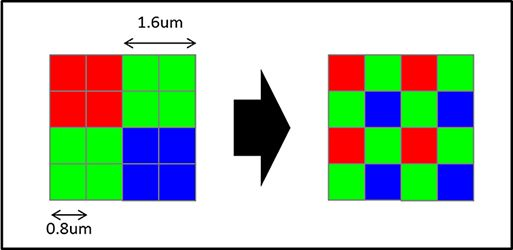But how does this work in practice? Are there trade-offs involved?
There are always trade-offs involved. In the case of quad-pixel and now nona-pixel sensors, the amount of color resolution is reduced from what one would expect to get from the full number of pixels.
For 48MP quad-pixel sensors that output 12MP when using binning, their color resolution is equal to about 27MP when using algorithms to rearrange the subpixels among the logical pixels. It interpolates from this (on the left) to this (on the right):

Each group of four same-colored pixels is virtually "stretched" to 1.5 their linear size.
If I've done the math correctly (using 1/1.5 cubed instead of 1/1.5 squared), a 108MP nona-pixel sensor that gives 12MP image when binned will yield color resolution equal to 32 MP when interpolating in the above method. Or maybe I should have used the square of 1/2 instead of the square of 1/1.5? In which case you'd be right back to 27MP effective color resolution.
This article from xda-developers.com explains the effect with quad-pixel sensors in more detail.
Before 2018, essentially every smartphone camera had a Bayer color filter array. The Huawei P20 Pro and the Huawei Mate 20 Pro were the first phones to use Quad Bayer sensors. Simply put, a Quad Bayer sensor has less color resolution than a sensor with a standard Bayer layout. On the IMX586, for example, the physical color filters on the camera sensor only have an effective resolution of 12MP. The ISP of such sensors is able to achieve a virtual 48MP Bayer result out of the sensor by re-arranging the subpixels among the logical pixels. It should be clear that this approach isn’t as good as using a standard Bayer filter. What is the specific difference? According to AnandTech, the 48MP IMX586 has closer to 27MP of spatial resolution as it’s only able to increase spatial resolution half-way.
The link in the above quote includes this about quad-pixel sensors:
This means that the physical colour filters on the camera sensor only have an effective resolution of 12MP. Sony’s sensor ISP is able to achieve a virtual 48MP bayer result out of the sensor by rearranging the subpixel-data among the logical pixels. It’s to be noted that this method would result in an effective spatial resolution increase of only half-way to 48MP, and actual results would be of clarity somewhere in the range of a true 27MP bayer sensor.
Samsung themselves hype their tetracell (quad-pixel) technology, along with other sensor innovations here. But Dieter Bohn at The Verge wasn't very impressed by the actual performance that 108 MP promises for the ability to zoom.


